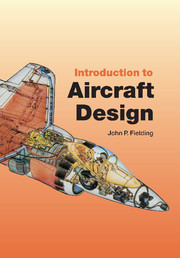Book contents
- Frontmatter
- Contents
- Preface
- Acknowledgements
- 1 Introduction
- 2 Why should we design a new aircraft?
- 3 Why is it that shape? – Civil aircraft
- 4 Why is it that shape? – Other types
- 5 What's under the skin? – Structure and propulsion
- 6 What's under the skin? – Airframe systems
- 7 What's under the skin? – Avionics, flight control and weapon systems
- 8 Why do aircraft cost so much?
- 9 What help can I get? – Bibliography and computer-aided design
- 10 The shape of things to come – Should the project continue?
- 11 What can go wrong? – Some lessons from past aircraft projects, and a glimpse into the future
- Appendix A Useful aircraft design data
- Appendix B A–90 parametric study. Example – the A-90 500-seat airliner
- Appendix C The prediction of aircraft reliability and maintainability targets
- References
- Index
11 - What can go wrong? – Some lessons from past aircraft projects, and a glimpse into the future
- Frontmatter
- Contents
- Preface
- Acknowledgements
- 1 Introduction
- 2 Why should we design a new aircraft?
- 3 Why is it that shape? – Civil aircraft
- 4 Why is it that shape? – Other types
- 5 What's under the skin? – Structure and propulsion
- 6 What's under the skin? – Airframe systems
- 7 What's under the skin? – Avionics, flight control and weapon systems
- 8 Why do aircraft cost so much?
- 9 What help can I get? – Bibliography and computer-aided design
- 10 The shape of things to come – Should the project continue?
- 11 What can go wrong? – Some lessons from past aircraft projects, and a glimpse into the future
- Appendix A Useful aircraft design data
- Appendix B A–90 parametric study. Example – the A-90 500-seat airliner
- Appendix C The prediction of aircraft reliability and maintainability targets
- References
- Index
Summary
Introduction
The design, manufacture and operation of aircraft are very complex and potentially risky activities. There is a natural tendency towards trusting tried and tested configurations, and adopting an evolutionary approach. There are many cases, however of revolutionary design changes, such as the advent of the jet engine, or the delta wing. Revolution involves more risk, but can be very rewarding. The history of aircraft design has had many examples of excitingly innovative, not to say weird designs. A minority of these are successful, some marginally successful, but many have been failures, some of them disastrously expensive failures! This chapter will describe a number of different projects and attempt to classify the reasons that led to their difficulties.
On a more positive note, the chapter will conclude with describing of a number of innovative designs which might have a great influence on the future of aeronautics – positively or negatively!
Aircraft that suffered from requirements that were too restrictive, too ambitious or were changed during development
Ward contains many examples of such projects from the depressing record of British aircraft developments since 1945, and several examples will be repeated here, both civil and military. Other sources were used for later aircraft.
The Hawker Siddeley Trident
This aircraft (Fig. 11.1) had many years of successful service in the UK and in China, and was a pioneer in the field of automatic landing, but sales were disappointing.
- Type
- Chapter
- Information
- Introduction to Aircraft Design , pp. 163 - 178Publisher: Cambridge University PressPrint publication year: 1999



